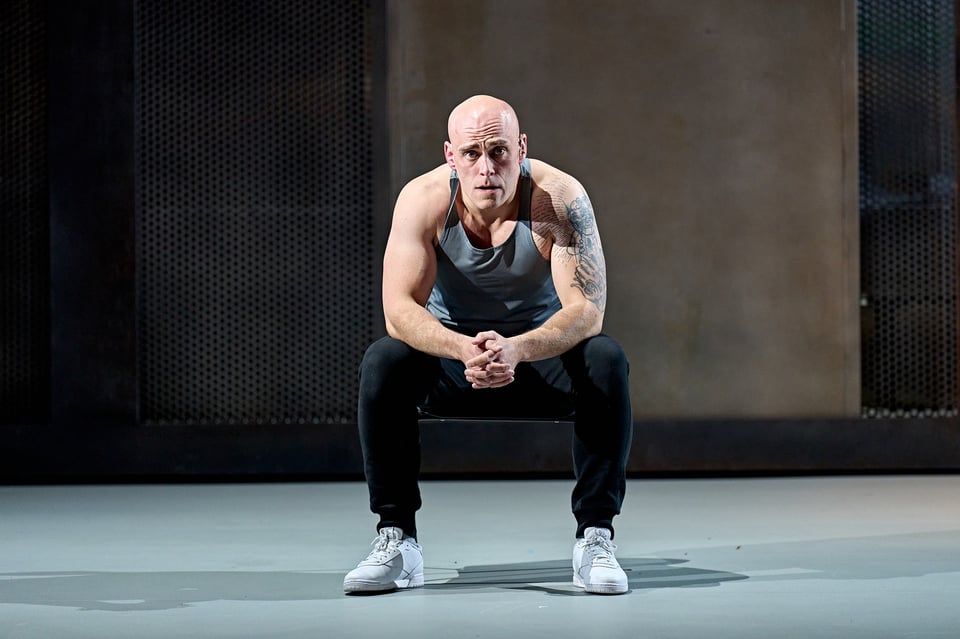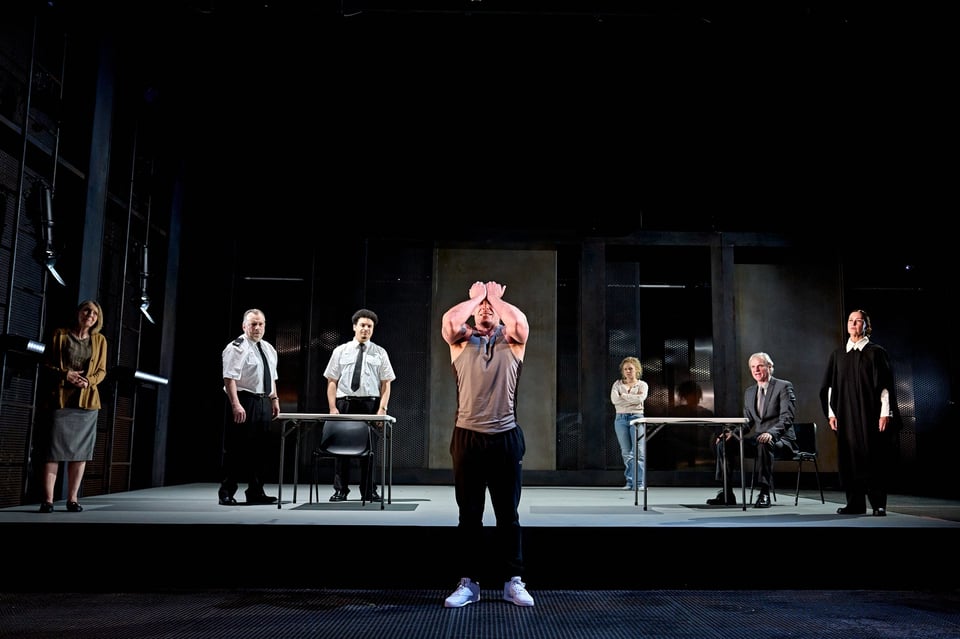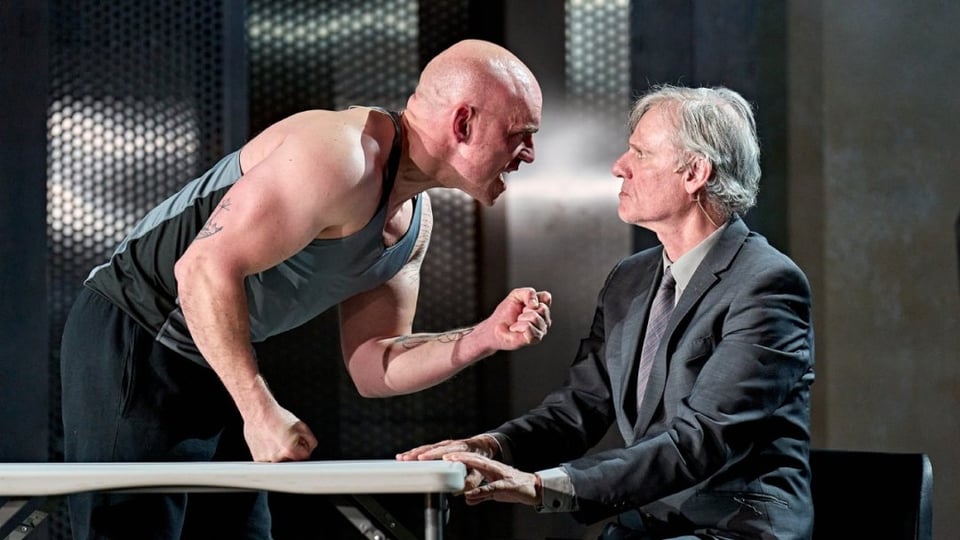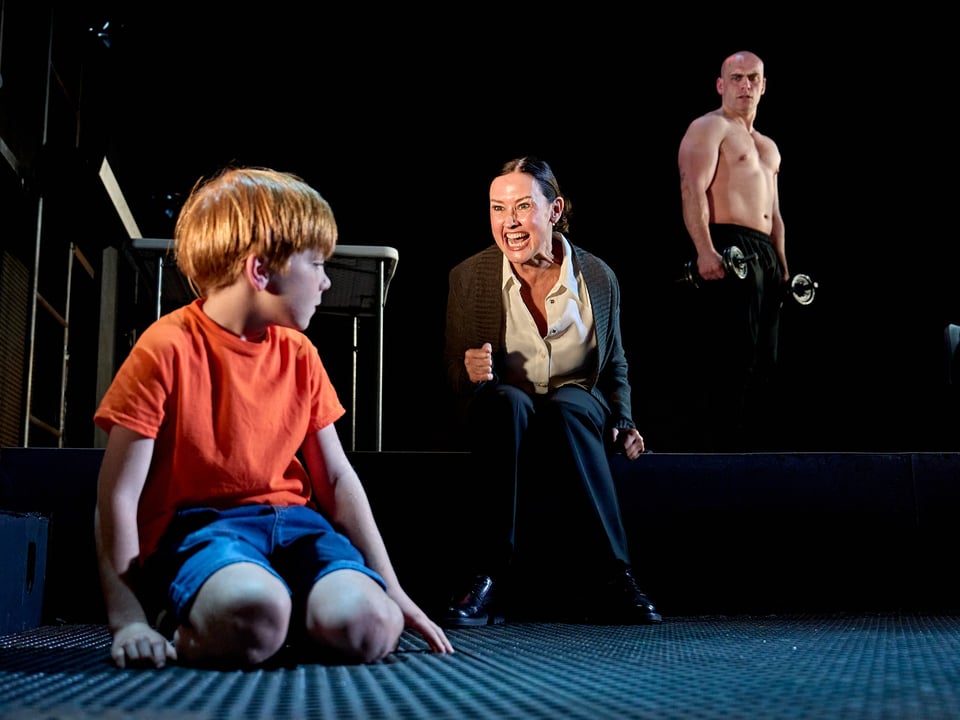Robert_Icke_Limp_Bizkit_Break_Stuff_LiveHiddenTrack.mp3
Let's get talking about Manhunt, Robert Icke's true crime drama-turned-psychological horror about Raoul Moat and other 'forgotten men'.

Kia ora koutou katoa and welcome back to Post-Electric, a blog about theatre and culture in the age of the profit-driven blackout.
I’ve been flathunting for the last couple of weeks, which means I’ve been getting back into the habit of Summarising Myself. To demonstrate my worth to prospective housemates, I’ve been working on a menu of sentences that break down who I am, what I like, what I’m like to live with. Near the top of the list at the moment is, ‘I’m out four-five nights a week,’ which I hope makes me sound mysterious and exciting. But it’s also just true - there’s so much going on, so many things to see, and I know I’m not going to be here (London/mortality) forever, so I’m throwing myself around the city trying to absorb as much as possible.
This also gives me a lot of time to think (and overthink) about shows when I’m writing about them, which is part of why I’m just coming to you now about Robert Icke’s production of Manhunt, which ended its run at the start of the month. I’ve been turning this one over in my mind for a bit, figuring out what I love and what I hate, what worked for me and what felt like shit. This blog is that.

Manhunt
Royal Court Theatre
wri/dir: Robert Icke
28 March - 3 May 2025
In Manhunt, when Raoul Moat is released from prison, the first thing he does is get a haircut. ‘A Mohican, like Travis Bickle.’ Over the next seven days, Moat will shoot his ex and kill her new boyfriend, shoot a cop in the face and blind him for life, spark off the largest manhunt in British history, have an hours-long stand-off with Northumbria police, and ultimately kill himself on the banks of the River Coquet. And so this haircut is a potent way to start the week, the self-pitying bodybuilder grabbing at the cultural immortality of Scorsese’s disturbed, self-immolating vigilante. But director Robert Icke denies us the image. His Moat, played by Samuel Edward-Cook, is bald as a cueball; that Mohican can only be imagined, a trick of the light. A projection.
Manhunt, which wrapped at the Royal Court Theatre a couple of weeks ago, is obsessed with the act of projection, the invisible things we see in people make them represent. After all, Moat, the 37-year-old bodybuilder and odd-jobsman whose manhunt dominated UK headlines in 2010, spent his life trapped in a web of what he projected onto others. He was convinced that he was being persecuted by the authorities, particularly Northumbria Police, and if anyone ‘turned against him’ - like his ex, Samantha Stobbart, who broke it off with Moat while he was in prison for hitting one of his children - they were quickly rolled into his self-made conspiracy.
In the wake of his rampage and suicide, Moat transformed into a battlefield of competing projections. Famously, a Facebook page titled ‘RIP Raoul Moat You Legend’ attracted 35,000 likes, with users casting Moat as a folk hero who had gone out guns blazing against whatever was pissing them off at the moment, whether it was the cops or soy boys or the family court. Prime Minister David Cameron - who, at the time, was spearheading the development of the ‘hostile environment’ policy that would wrongly and violently target thousands of Windrush generation immigrants for deportation - used the moment to claim some cheap moral authority, telling Parliament that Moat was a “callous murderer, full stop, end of story.”
Cameron’s moral grandstanding features in the play and serves as its tagline. It’s clearly an artefact of interest for Icke, who’s well-regarded for exploring the tense space where we cling to absolutes even as they fail us (Manhunt follows hot on the heels of the Olivier-winning West End transfer of his adaptation of Oedipus, the ultimate story of a dude failed by his dogma). Cameron’s condemnation of Moat as a kind of vile creature, Icke argues, is but one example of our unwillingness to try and understand those who do violence, an unwillingness that dooms us to repeating this pattern - a man explodes, destroying everyone in his blast radius, and we all shake our heads at how callous he was for exploding.

To try and understand Moat, Icke surfaces a number of theories for his violence and influences on his behaviour. Moat’s a bigot and his friends are all bigots; Moat’s paranoid and a survivor of abuse and might be mentally ill; Moat’s on steroids to get big so that women will love him and men will respect him; Moat’s just been to prison and he can’t make ends meet and his girlfriend’s left him and he can’t see his kids and he might lose his flat and the police are harassing him and maybe they aren’t but it doesn’t matter if that’s true because that’s how he perceives it because his vision of masculinity - as an inheritance of power and fealty that he’s been denied all his life - is a prison that he’ll never escape and maybe he doesn’t actually want to escape. And any or all of these things might be true.
And look, I admire that Icke’s trying to show us Moat in full, that he’s working to understand the awful composition of the soil in which this kind of violence grows. This kind of portrait is a necessary antidote to the contemporary model of true crime, which overwhelms its audiences with lurid tales of violence and murder and then invites them, through editing and scoring and performance and source selection, to see the solution in policing and incarceration, these “presumptive antidotes.”1 Icke’s initially careful about where and how he draws conclusions, but Manhunt is sickeningly effective whenever we’re observing the feedback loop between the local authorities and Moat’s growing victim complex. In an impossibly tense early sequence, Moat is overwhelmed by calls from the police and Justice and housing services and social services. Edward-Cook is pulled from one scene to the next like he’s on a chain, and as lights and shadows change with no warning and increasing speed, we’re just as disoriented, trying to catch up as we watch a man’s life seem to slip through his fingers.
Those presumed antidotes are so poisonous to Moat that Icke makes his inner voice of reason a barrister - but he also makes that voice of reason a woman, foregrounding Moat’s intense hostility to women and his violent relationship with his own masculinity. And Moat’s not the only straight white man in crisis in Manhunt. Moat’s best mates, beta dipshits in comparison to their raging alpha, mindlessly parrot and feed his misogyny. Paul Gascoigne, the legendary footballer who famously turned up to the riverside standoff armed with beers, chicken and a fishing rod, is imagined here using Moat as a conduit for his own gendered trauma, pouring his heart out over how he was humiliated and emasculated by the British public after crying at the 1990 World Cup.

And then there’s DC Paul Rathburn, the cop Moat blinded with a shotgun to the face. Rathburn is the only victim who gets to exist outside of Moat’s mind, in a show-stopping (value-neutral) monologue played out in complete darkness. Icke’s imagination of Rathburn is loaded with echoes of his assailant. Here’s Moat, telling us about his suicidal thoughts while he’s with a friend and lamenting “I don’t say any of that”; here’s Rathburn, telling us about his suicidal thoughts, “but I don’t tell my wife any of that.” Here’s Moat’s infamous Facebook post, “Just got out of jail, I've lost everything, my business, my property and to top it all off my lass has gone off with someone else”; here’s Rathburn twenty minutes later, “I lost my faith, lost my job, lost my eyes.”
Rathburn’s monologue is where Manhunt really starts to sour for me. Nicholas Tennant plays Rathburn with the kind of gasping, cracking intensity you get in a Louis Saunderson video - BLINDED POLICE OFFICER CONFESSES EVERYTHING 💔 #sad #grief #awareness. It’s mawkish emotional spectacle dressed up as concern for Our Men, the Jeremy Kyle interview we can’t get. It’s less interested in a moment of actual emotional honesty from Rathburn than it is in the volcanic spectacle of bottled-up male vulnerability.
As we get deep into the final act, Icke can’t stop indulging this. Not just in Rathburn’s monologue, not just in the imagined meeting with Gazza. It’s in an imagined meeting between Moat and his absent father, a replay of the Gazza scene in case you’re Not Getting It. It’s in a series of hysterical flashbacks to Moat’s abusive past, his Hammer Horror mother shrieking as she sets his toys on fire. It’s in a birds-eye view projection of Moat being carried off by paramedics set to The Who’s Behind Blue Eyes, the kind of try-hard hard-man moment that wouldn’t be out of place in a music video for the Limp Bizkit cover. By the time we get to the show’s sanctimonious final monologue, Icke ventriloquising Moat to deliver a sombre warning about the world’s ‘forgotten men’, I’m out entirely - the last three pages of notes I took during the show are increasingly large, increasingly capitalised descriptions ending with ‘COME ON’.

Manhunt solidifies how I felt about Icke coming out of his Oedipus five years ago - Icke isn’t interested in the people he’s writing, he’s interested in what they represent. In Oedipus, that results in a politically muddy show that’s hijacked by its big red magic trick, an on-stage alarm clock that counts down to the big reveal. In Manhunt, that results in Icke joining the battlefield for Moat as a symbol, projecting his perspective on the rise of the male supremacist onto his subject.
Despite that, I wanna be clear, Icke is grotesquely talented at creating spectacular emotional moments. For the last three weeks I’ve been thinking about the last truly incredible moment in this show, the build-up to Moat’s attack on Samantha Stobbart and her boyfriend Christopher Brown. Edward-Cook’s building anger and wound-up body language as Moat’s paranoia kicks into overdrive, the blown-out live feed of Samantha and Christopher and their friends talking about how much they don’t miss that dickhead, Frankie Valli and the Four Seasons’ The Night climbing and climbing to the moment, the hurricane finally touching land.
By the end, though, Manhunt is blunt, pious, disconnected from its subjects. It’s one thing for us to not know who Samantha and Christopher are.2 It’s lacking in empathy, but of course it is, you might argue, this is a show about Moat, how he saw the world. But by the end of Manhunt, we’ve even lost Moat, the experiences and grievances and violence that made him him. He's become smaller, this whole thing's become smaller, a diagnosis, a sermon, reductive and boring and bad drama. Just Icke, speaking through Moat’s dead, immortal mouth, trying to Start A Conversation.
That's all for this week! I’m heading to the Royal Court right now, this time for Joel Tan and emma + pj’s Scenes from a Repatriation. If you have thoughts about this piece, about Manhunt, or about anything else, you can definitely email me here (thank you to Hannah for testing that and finding it working - I’m going to email you back! I promise!). And if you liked it, please share it out!
Until then, thanks for reading! Keep safe, keep well, keep sinewy,
Adam
That description comes from Daniel Garber’s ‘Can’t Look Away: How True Crime Series Are Edited’, for Filmmaker Magazine, a great article about interviewing a bunch of true crime documentary editors while on a true crime cruise, the kind of deeply deranged human activity that makes me wonder if our existence was worth it. The observation of policing and incarceration being seen as ‘presumptive antidotes’ to crime, and that presumption being fuelled by true-crime-induced paranoia, comes from a wild source: Tiger King editor Dylan Hansen-Fliedner. But, I mean, while you can accuse that show of a lot, I guess you can’t accuse it of making people feel they’re under siege from Tiger Kings. ↩
I really like Natasha Tripney’s perspective on this, over in her newsletter Cafe Europa, exploring how Manhunt, and stories like it, deal with (and so often sideline) the women who are victims of misogynistic violence. ↩